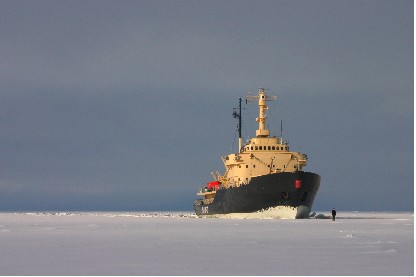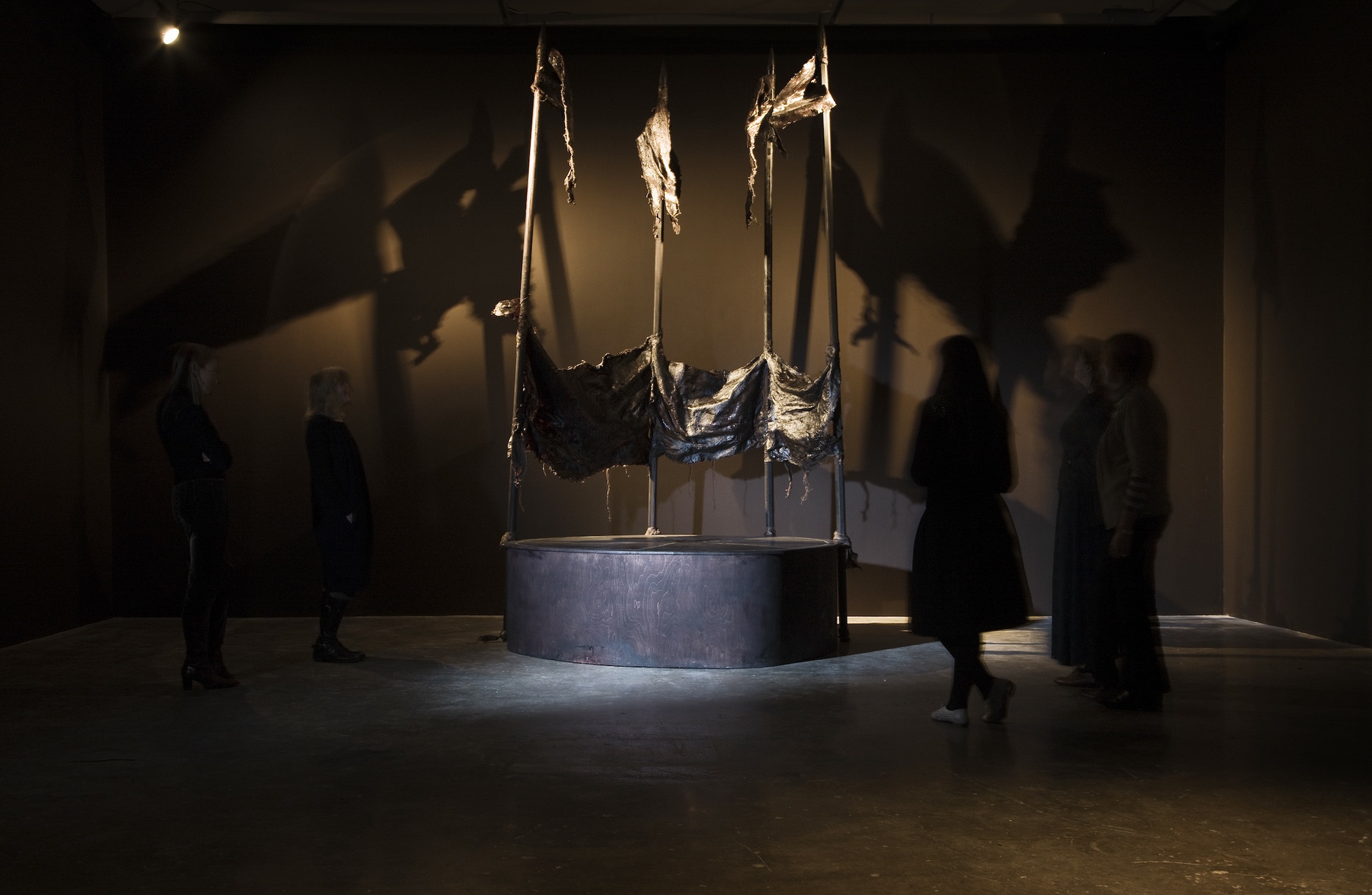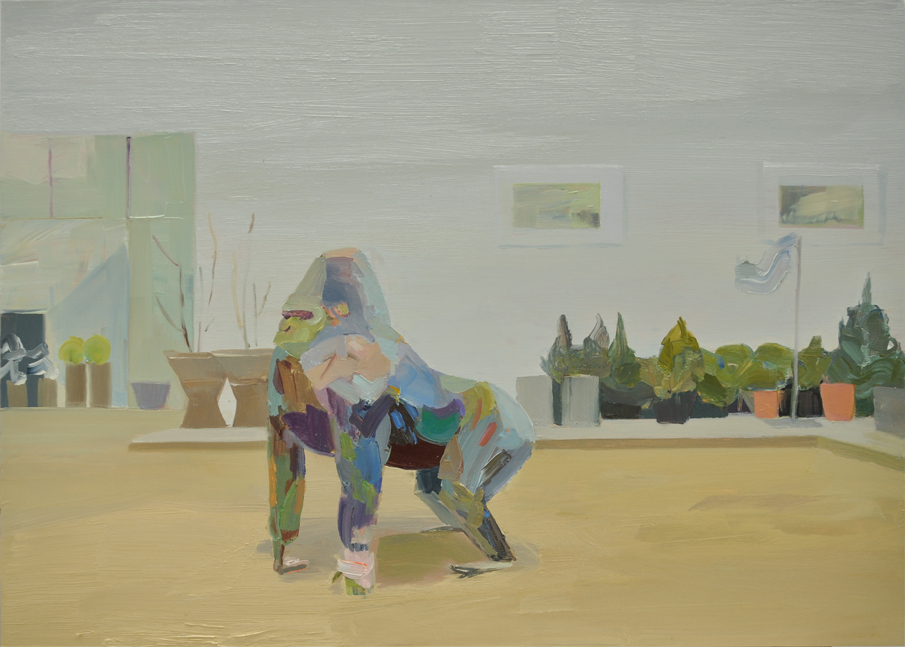Guido van der Werve cannot be said to do things by halves; from standing on the North Pole for twenty-four hours and turning in the opposite direction to the earth’s rotation to running a marathon and laying flowers on Rachmaninov’s grave, van der Werve is famed for the power of his elegant films. Still in his thirties, he has already amassed an impressive CV, showing his work in museums and galleries across the world.

Guido van der Werve – Nummer acht: Everything is going to be alright
still, 2007
16mm film, 10 min
Image by Johanna Ketola
Image courtesy the artist.
A small group gathered to hear van der Werve speak before the opening of his exhibition at the Model, Sligo. A charming if diffident host, van der Werve talked us through his practice, from his earliest experiments to his latest films. Initially reluctant to become an artist, and follow the example set by his father and brother, van der Werve floated between various universities in his native Netherlands studying archaeology, industrial design, and even training in classical piano and composition at a conservatory. He began to grow interested in making performances but, too shy to perform in public, asked his friends to film him. Throughout his talk, van der Werve played clips from his earlier work, joking about his youthful appearance in Suicide 8945 till 8948 (2001) in which van der Werve stares blinkingly at the camera while appearing to shoot himself in the head repeatedly (with attendant sloppy splashes of gore).
As he grew acquainted with the contemporary art scene in Amsterdam, van der Werve soon realised that he felt more inspired by music and film and set about producing work that would have an equally rousing effect. One of the first films to bear the hallmarks of his mature work Nummer Twee: Just because I’m standing here, doesn’t mean I want to (2003) achieves this to stunning effect, and gloriously so. Dressed in black and standing on a banal suburban street [1], the artist faces the camera and slowly steps backward whereupon he is violently knocked over by a speeding car. There follows an extraordinary sequence where a van pulls up at the side of the road and a small troop of ballerinas emerge from the back (the balletic equivalent of clowns emerging from a miniature car). With the artist’s body slumped on the road behind them, these tutu-ed apparitions perform a graceful dance on the tarmac, accompanied by exquisite music that transforms this grim site of bodily violence into something strangely uplifting, magical and mysterious.
Similarly compelling is Nummer vier: I don’t want to get involved in this, I don’t want to be part of this, talk me out of it (2005). Opening poetically with the lines ‘I woke up early and watched the sun rise. I felt it came up just for me,’ the artist performs one of Chopin’s Nocturnes [2] on a piano which sits on a raft in a lake, the sky reflected in water to infinity. Romantic and melancholic, the music fits perfectly with the sight of the artist sitting serenely afloat in a verdant landscape. The tone switches from wistful to enthralling when, a few moments later, we see a boat floating down a river (in what looks like the same landscape as in the establishing shot). Mozart’s Requiem Mass grows louder as the boat approaches the camera until finally, its cargo – a full orchestra and choir – is revealed. For a thrilling, all too brief moment, we are immersed in their song before they drift on again, out of sight and out of sound. The subsequent stillness is dramatically interrupted by the artist falling out of the sky and plunging into the river.
Later works grew more elaborate in scope, moving from quotidian north European landscapes to the Arctic wastes of the North Pole. Nummer acht: Everything is going to be alright, which features the artist walking in front of an enormous icebreaker, is devastatingly effective as a single image, though perhaps less compelling as a film. Similarly, while the performance at the centre of Nummer negen: The day I didn’t turn with the world, 24 hour performance at 90 deg latitude, 00 deg longitude, The geographic Northpole: the North axe of the earth (2008) is a grand and epic gesture, it seems less successful than the earlier works in all their emotional intricacy.
For this exhibition at the Model, van der Werve is showing two films which, while longer than Twee and Vier, are similarly stirring. Nummer Zes: Steinway grand piano wake me up to go to sleep and all the colours of the rainbow (2006) follows van der Werve’s love affair with the Steinway piano and culminates in a glorious performance. More enigmatic, but equally captivating, is Nummer twaalf: Variations on a theme: The King’s Gambit accepted, the number of stars in the sky and why a piano can’t be tuned or waiting for an earthquake (2009) in which van der Werve traverses landscapes, pondering the nature of infinity via the chess move.
The influence of cinema is apparent in van der Werve’s sensitive pairing of evocative imagery and elegiac music, recreating its immediate emotional impact without recourse to dialogue or narrative. The artist works very much from the heart, describing his process as intuitive and his films as attempts to share ideas that are simple and direct. Though the films may sound peculiar – full of unexpected moments and seemingly no rational connection between the actions of their protagonists – they are deeply moving, in the same way that it can be impossible to pinpoint exactly why a particular song hits us in the gut. Timeless and unforgettable, this is work that is unafraid to search for the grand, sweeping moment, to find meaning in mundane places, in everyday life and settings. If you have ever wished that your daily life had a soundtrack, then I recommend you get to Sligo before the exhibition closes and see van der Werve’s evocative mini-masterpieces for yourself.
Ciara Moloney is a writer based in Dublin.
_________________________________________________
[1] I learn later that this is the street van der Werve grew up on.
[2] No.1 in B flat minor, in case you were wondering.




